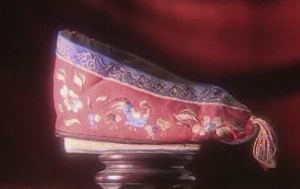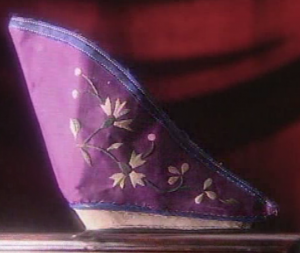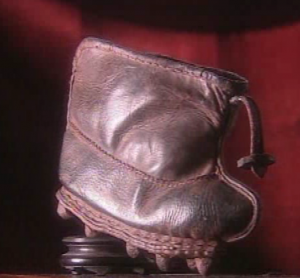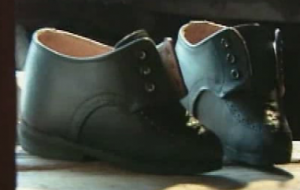Chinese footbinding has existed for upwards of a thousand years. Since its inception among the upperclass and nobility, it gradually spread to working class Chinese as well. The process of footbinding involves the breaking of multiple bones in the foot and wrapping of the injured area and lower leg. This painful process leaves the woman in a state of discomfort for years and subsequently, makes walking and independent movement very difficult, if not impossible. Because of this, it was a sacrifice to the family of working class women to bind the feet of their daughters who would not longer be able to provide labor the family might desperately need.
may start from here: In the four images in this post, we see two very distinct types of golden lotus shoe. The first two, are what we might expect. They are small, dainty, and beautiful, while the other two are utilitarian and bulky. In comparing these images, I will explain how the reality versus the dream of footbinding affected working class women so much.

Source: Chinese Footbinding: The Vanishing Lotus. 2004
These golden lotus shoes are intricate and delicate. We see that they are carefully hand embroidered with many important symbols. In the red shoe with a tassel, there is a delicately stitched rooster. This indicates a good marriage between the wearer and her husband. The tassel further indicates the plush and dainty lifestyle of the wearer. She is an ornament. The purple shoe shows embroidered flowers which one can interpret as the sign for wealth and success. These shoes would have been worn by a young unmarried woman.

Source: Chinese Footbinding: The Vanishing Lotus. 2004
These shoes are incredibly delicate, and meant to be worn by women who would not often walk around outdoors. One can see this because of how intricate the embroidery of the silk is. Wearing these shoes outdoors in the elements would be a waste of them, they’d be ruined.
In contrast, these next two images show shoes that are much more practical for outdoor use. Both the shoes in these images are made of leather, a durable material, more appropriate to outdoor use. In the first of these shoes, we see small crafted spikes on the bottom of the shoe. The stitching and base of the shoe all indicate something created for wear and tear, or at the very least, repeated use. The shaft of the shoe goes up higher than other golden lotus slippers, possibly indicating that it is meant to protect the wearer from snow or rain, various other elements.

Source: Chinese Footbinding: The Vanishing Lotus. 2004
The second pair is even more utilitarian than the first. It is also made of leather, and is meant for stability as indicated by the flat sole and sturdy front flaps with eyelets for laces. These are neutral in color, black, and meant to be worn everyday.

Source: Chinese Footbinding: The Vanishing Lotus. 2004
The difference in these shoes shows the difference in the lives of rich and poor footbound women. Rich women could afford to wear the delicate embroidered silk shoes, and lounge about their home. Poor women still had to work however, and as such wore more utilitarian, practical shoes. While footbinding was the ideal of beauty for more than a thousand years, its appeal was much more for the dainty embroidered shoes. The reality of footbinding for women of a working class was not the beautiful shoes we’re accustomed to seeing in context of footbinding, but rather these plain, utilitarian shoes.
detailed comparison. the difference could mean different materials in different time
